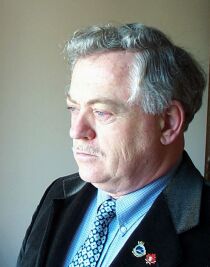
|
 |
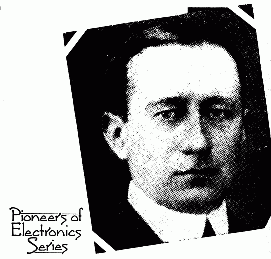 MARCONI
MARCONI
From Electronics Today International July 1982:
A name that needs no introduction.
MARCONI had a decidedly good start to life. Born in Bologna, Italy, of a titled Italian father and an Irish mother, he was brought up on his father's estate and educated in Bologna and in Florence. He then went to technical college in Leghorn, where he specialized in physics (still the best grounding for any engineer) and interested himself, particularly, in the work of Maxell, Hertz and Sir Oliver Lodge. By 1894, his interest in radio was such that he started a series of experiments at his father's estate. His transmitter used the classic design of Heinrich Hertz, an induction coil with a spark-gap (Fig. 1), 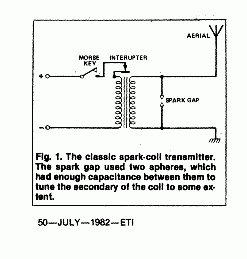 and his receiver used the equally well-established coherer (Fig. 2). and his receiver used the equally well-established coherer (Fig. 2). 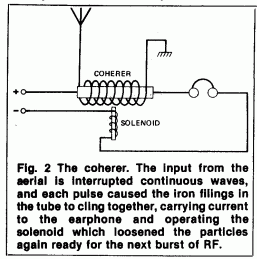 What distinguished Marconi's work from that of the many other pioneers, working with the same equipment at the same time, was his particular interest in aerials, an interest which had sprung from his study of Maxwell's beautifully symmetrical equations of electromagnetic radiation. What distinguished Marconi's work from that of the many other pioneers, working with the same equipment at the same time, was his particular interest in aerials, an interest which had sprung from his study of Maxwell's beautifully symmetrical equations of electromagnetic radiation.
His own notes on these early experiments show that he was using a vertical aerial with a ground plane, the classic type of aerial still in widespread use today. Very significantly, his notes show that he was obtaining ranges of about 1 miles and that he had found that, by using a reflector behind an aerial, he could beam the radiation, increasing the range and obtaining better directional characteristics.
Finding that there was little interest in Italy for his pioneering work, in 1896 he travelled to London to work with Sir William Preece, then Chief Engineer of the Post Office. The Post Office, at that time, was taking a keen interest in the new developments, and Preece encouraged the young Marconi to file patents on his work.
Marconi backed up his patents with a series of demonstrations which indicated the increased ranges that were possible by the use of aerials held up by balloons or kites. He achieved a range of four miles on Salisbury Plain, nine miles down the Bristol Channel and, in 1897 at Le Spezia, was able to demonstrate communication between warships at sea and a land station 12 miles away.
The Wireless Telegraph Co.
By this time, Marconi and his coworkers were convinced that radio could be put to serious use so Marconi and his cousin, Jameson Davies, an engineer, financed a number of patent applications and formed the Wireless Telegraph and Signal Compary Ltd. In 1900 the company changed its name to Marconi Wireless Telegraph Co., a name which it retained up to the 60s.
During this time, each demonstration by Marconi indicated a greater, and therefore more useful, range of communication; 75 miles, between battleships in 1899, for example. Transmission and reception conditions proved to be better at sea than on land so that, after several demonstrations of this type, the Marconi International Marine Co. (MIMCO) was formed specifically to equip and maintain radio in sea-going vessels. For the first time, it had been possible to communicate between, ships which were not visible to each other and, given the importance of sea transport at that time and the length of sea journeys, it was a most sensible approach. Another clutch of patents followed, the most significant of which described the principles of tuning both the transmitter, and the receiver so that it was possible for several transmitters to operate at the same time on different wavelengths without interfering with each other.
Several navies around the world were now installing the 'Marconi Apparatus', as radio was known, and the design of transmitters, receivers and new model that was constructed. Marconi, however, was not satisfied with gradual development and insisted that nothing short of a signal sent across the Atlantic would convince his many skeptical opponents that radio was an invention of real importance. His proposals were scoffed at, because enough was known of radio waves to make it clear that they traveled, like light waves, in almost straight lines and were most unlikely to follow the curvature of the Earth across the Atlantic. Marconi, however, seems to have had different ideas, probably due to the long ranges he had already achieved at sea. Oddly enough, the work of the shy genius Oliver Heaviside, decades earlier, had showed that long-range radio communication would be possible because of the probable existence of an 'ionosphere', a layer of split atoms high above the atmosphere which would reflect wave radio signals like a sheet of chicken-wire.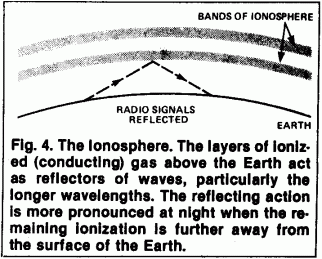 Very few engineers, however, had read Heaviside's report and fewer still could follow his arguments, so that it seems likely that Marconi was not familiar with the theoretical basis of his experiment. In December 1901, amid foul weather on each side of the Atlantic, he succeeded in transmitting one signal, the Morse coded letter S (three dits) from St. John's in Newfoundland to Poldhu, Cornwall, establishing for the first time that long-distance radio communication was possible and in the process knocking thousands of pounds off the shares of companies concerned with trans-atlantic cables!
This success gave Marconi the impetus to press ahead with the development of long-range radio and he installed equipment of his latest design in the liner 'Philadelphia', which was then able to attain 300 miles by day and a staggering range of 2000 miles by night. It was this difference between day and night ranges, incidentally, which helped to confirm Heaviside's idea of the ionosphere (Fig. 4), which then gained support from a number of distinguished physicists. Patents continued to pour out from the Marconi development laboratories, including improved detectors and, significantly, a horizontal directional aerial system.
Very few engineers, however, had read Heaviside's report and fewer still could follow his arguments, so that it seems likely that Marconi was not familiar with the theoretical basis of his experiment. In December 1901, amid foul weather on each side of the Atlantic, he succeeded in transmitting one signal, the Morse coded letter S (three dits) from St. John's in Newfoundland to Poldhu, Cornwall, establishing for the first time that long-distance radio communication was possible and in the process knocking thousands of pounds off the shares of companies concerned with trans-atlantic cables!
This success gave Marconi the impetus to press ahead with the development of long-range radio and he installed equipment of his latest design in the liner 'Philadelphia', which was then able to attain 300 miles by day and a staggering range of 2000 miles by night. It was this difference between day and night ranges, incidentally, which helped to confirm Heaviside's idea of the ionosphere (Fig. 4), which then gained support from a number of distinguished physicists. Patents continued to pour out from the Marconi development laboratories, including improved detectors and, significantly, a horizontal directional aerial system.
The first spectacular broadcast across the Atlantic was followed by events which captured the imagination of the public; the capture of the mass murderer Crippen on board ship, thanks to a radio message sent out from London, and the use of radio during the sinking of the Titanic in 1912. The Titanic disaster eventually led to the full-scale installation of radio in all ocean-going ships and the establishment of an emergency wavelength which was kept clear at all times and which operators were obliged to monitor for distress calls.
By this time Marconi, awarded the Nobel Prize in 1909, could have retired, assured of fortune and fame in equal proportions and with the inherited Italian title of Marchese. The work of the true pioneer, however, is always concerned with the next step and by the end of the First World War, Marconi was ready with more new ideas. By this time too, his employee David Sarnoff, in the USA, was convinced that radio had an equally bright future as an entertainment medium. Marconi was totally opposed to this, though he took an interest in the first demonstration of public broadcasting from Writtle (near the Marconi works in Chelmsford) when the diva Dame Nellie Melba, using a microphone hastily rigged up with a cigar-box mouthpiece, made what was almost the first broadcast using amplitude modulation (she had been preceded by one of the office secretaries who had been asked to test the equipment before Melba arrived). Marconi, however, refused to consider involving the Marconi company in the business of public radio reception and defined the firm's role as that of providing transmitting equipment and specialized receivers for communications only. Sarnoff resigned to form his own company, the Radio Corporation of America, but Marconi sold the use of his name for domestic receivers. This was a step that his fellow-directors bitterly opposed and, after Marconi's death, the Company tried to buy back the Marconiphone trademark, without success.
Moving on with more experiments, Marconi converted his steam yacht, the Elettra, to act as a floating laboratory for the development of short-wave transmitters and receivers. By 1924, he had obtained a contract from the English post office to manufacture short-wave transmitters and receivers for the cablegram service and, by 1932, he was working with half-metre wavelengths, getting close to the wavelengths that would soon be used in the early radar experiments. There is little doubt that Marconi himself would have taken the initiative in radar had his health been better. As it was, he died in 1937, surrounded by the tangible evidence of his success and with a worldwide organization centered on his adopted home town Chelmsford, Essex.
As a footnote, the career of the yacht Elettra is worth recording. She was used as a test laboratory by MIMCO after Marconi's death but met her end, like so many others of her age, at Dunkirk. After the Second World War, a converted motor torpedo boat was bought and named Elettra II, to be used for the same purposes. It was a remarkable hulk, so top-heavy with aerials and radar equipment that when it rolled, there was a sickening delay before it righted itself. Then, after a tour of Norway, it was found that all but one of the stringers (the longitudinal beams that were supposed to hold the ship together) were broken! Shortly after that it was scrapped and a new Elettra III commissioned.
Go to Index Page
|

